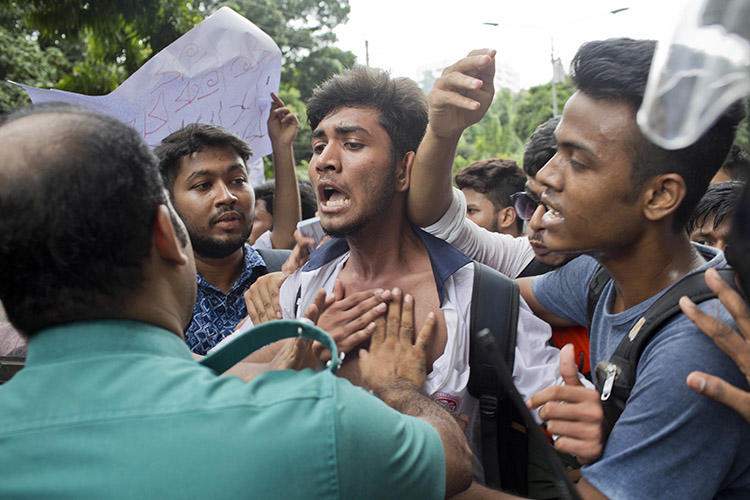On July 29, two students were killed, and 12 others injured when a bus plowed into a passengers waiting at a stop in Dhaka. Since then, daily demonstrations that started in Dhaka have spread throughout Bangladesh. Thousands of students have demonstrated on the streets of Dhaka at major traffic intersections, causing congestion that has nearly paralyzed the city according to The Straits Times. The protesters are calling for tighter control of the transport sector that is regarded by many as corrupt, dangerous and in need of regulation.
Protests intensified over the weekend, and more than 200 people were injured after police fired rubber bullets at protesters. More than a dozen journalists from various news organizations were attacked while documenting the protests, allegedly by police and supporters of the ruling Awami League party, according to news reports. Among them were several photojournalists who had their equipment damaged or destroyed, or who were forced to delete their photographs or video footage.
CPJ’s Emergencies Response Team issued the following safety advisory for journalists covering or planning to cover the protests in Bangladesh.
- Plan the assignment and ensure that you have a full battery on your mobile phone. Know the area you are going to. Work out in advance what you would do in an emergency.
- Always try to work with a colleague and have a regular check-in procedure with your base. If you are a photographer, try to work with a partner who can keep their eyes on the street while you focus on shooting. It is easy to lose situational awareness while viewing a scene only through a lens.
- Wear clothing and footwear that allows you to move swiftly. Avoid loose clothing and lanyards that can be grabbed as well as any flammable material (i.e. nylon). Wear camera straps on your shoulder, not your neck, to avoid being strangled if the camera is grabbed.
- Consider your position. If you can, find an elevated position that might offer greater safety. Make sure elevated positions have multiple exit points, to avoid getting trapped.
- At any location, always plan an evacuation route as well an emergency rendezvous point if you are working with others.
- Maintain situational awareness at all times and limit valuables you are taking. Do not leave any equipment in vehicles as they are likely to be broken into. After dark, the criminal risk increases dramatically.
- If working in a crowd, plan a strategy. It is sensible to keep to the outside of the crowd and don’t get sucked into the middle where it is hard to escape. Identify an escape route, and have a team emergency meeting point if working with others.
- If you are a photographer, consider carrying multiple CF or SD cards and switching them, so if your camera is stolen or you are forced to delete images, you don’t lose a full day’s work. Consider carrying the extra cards in a money belt or tight pocket.
If dealing with tear gas:
- Wear personal protective equipment including a gas mask, eye protection, body armor and helmet.
- Individuals with asthma or respiratory issues should avoid areas where tear gas is being used. Likewise, contact lenses are not advisable. If large amounts of tear gas are being used, there is the possibility of high concentrations of gas sitting in areas with no movement of air.
- Take note of any potential landmarks (i.e. posts, curbs) that can be used to help you navigate out of the area if you are struggling to see.
- If you are exposed to tear gas, try to find higher ground and stand in fresh air to allow the breeze to carry away the gas. Do not rub your eyes or face as this may worsen the situation. Once possible, shower in cold water to wash the gas away from skin, but do not bathe. Clothing may need to be washed several times to remove the crystals completely or even be discarded.
When dealing with aggression:
- Read body language to identify an aggressor and use your own body language to pacify a situation.
- Keep eye contact with an aggressor, use open hand gestures and keep talking with a calming manner.
- Keep an extended arm’s length from the threat. Back away and break away firmly without aggression if held. If cornered and in danger, shout.
- If aggression increases, keep a hand free to protect your head and move with short, deliberate steps to avoid falling. If in a team, stick together and link arms.
- While there are times when documenting aggression is crucial journalistic work, be aware of the situation and your own safety. Taking pictures of aggressive individuals can escalate a situation.
Journalists who are injured or require assistance can contact CPJ via [email protected].
For more information on basic preparedness, assessing and responding to risk, or safety measures when covering civil conflict and disturbances, journalists should review CPJ’s Journalist Security Guide. For additional information and tools for pre-assignment preparation and post-incident assistance, visit CPJ’s resource center.
CPJ encourages local and freelance journalists and media organizations covering the protests in Bangladesh to closely follow the safety principles and practices of the ACOS Alliance, which can be found here.
